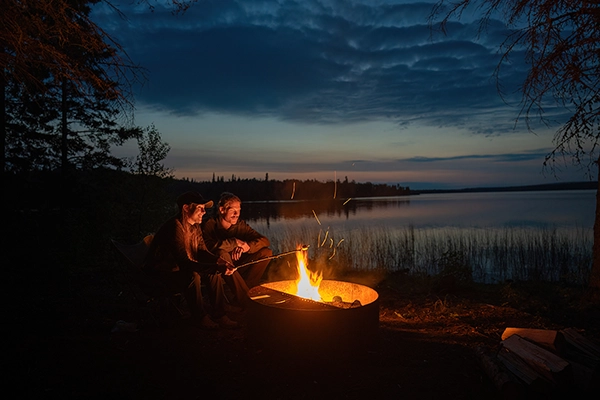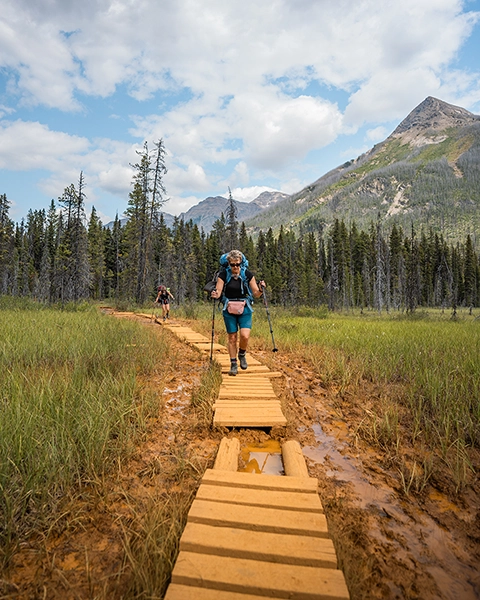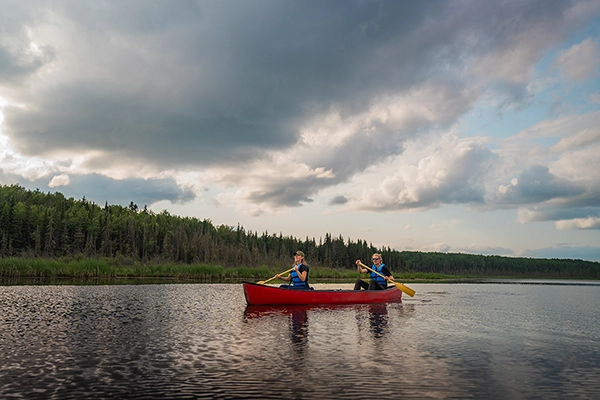Tamron Blogs
More Photo Tips | Video Gallery | Photo Gallery | Enewsletter sign-up
Into the Woods: Elevating Your Camping Photography With Expert Tips
Planning a forest getaway this year? Whether it's a serene retreat or an adventurous expedition, forests offer a captivating backdrop that's ripe for camping photography. Yet, capturing the enchanting essence of the woods can be as challenging as it is rewarding. This blog will equip you with essential strategies to tackle the unique hurdles of forest landscape photography and transform dense forest scenes into photographic masterpieces.
Mastering the Mystique With Natural Light: Golden Hour Photography
One of the quintessential tips for any photography in the woods is to harness the power of natural light. The natural light golden hour photography technique involves shooting during the golden hours—just after sunrise or before sunset. This time offers a soft, diffused light that enhances the mystique of forest landscapes by reducing the harsh contrasts often caused by the sun's direct rays penetrating the uneven canopy cover. During these hours, the light casts magical hues and elongated shadows, providing a natural filter that truly elevates the visual appeal of your shots.
To optimize the impact of golden hour light, position yourself in a spot where the light can filter through the trees at a low angle. This positioning captures a rich palette of colors and complex interplays of light and shadow, creating a layered depth in your photos. The play of light can transform an ordinary forest scene into a surreal, glowing landscape. Consider the direction and quality of light; early light tends to be cooler with a bluish tint, while the light just before sunset offers warmer tones.

Click image to view larger
Furthermore, mastering golden hour photography requires understanding the dynamics of exposure and white balance adjustments to accommodate the rapidly changing light. Using manual settings on your camera allows you more control to adapt quickly. As the light changes, you might need to adjust your ISO, shutter speed, and aperture to maintain the right exposure. Practicing these adjustments in various lighting conditions can help you become more adept at capturing the forest's beauty during these enchanting times.
Navigating Visual Complexity: Composition and Focus
Forests are visually complex. To create compelling compositions, focus on identifying patterns such as the repetitive alignment of tree trunks or a cascade of leaves. Using natural leading lines—like paths or streams—can guide the viewer’s eye through the image and add a sense of depth and story. For wide, encompassing shots, lenses like Tamron's 20-40mm F/2.8 Di III VXD or 11-20mm F/2.8 Di III-A RXD are excellent, as their ultra-wide angles allow you to capture expansive forest scenes without missing any intricate details.
When photographing forests, it's beneficial to consider the elements of the frame that will lead or distract the viewer's gaze. Strategic placement of visual elements can help to stabilize the image and give it a balanced feel. You might want to experiment with different vantage points—crouching low to include foreground elements like wildflowers or moss can add layers and interest to your composition. Additionally, the inclusion of a visual anchor, such as a distinctive tree or rock formation, can provide a focal point that draws the viewer deeper into the scene.

Click image to view larger
Enhancing your forest photography can also involve playing with scale and perspective. The enormity of a forest can be impressively conveyed through compositions that juxtapose the vastness of the environment against the finer details, like a single illuminated leaf or a delicate spider web. Such contrasts highlight the forest environment's diversity and create a narrative about the ecosystem. This technique encourages the viewer to appreciate both the grandeur and the minutiae of nature's designs.
Exploring New Perspectives: Getting Creative with Lens Choices
To truly capture the essence of the forest, don't shy away from experimenting with different perspectives. The 17-50mm F/4 Di III VXD lens, for example, is ideal for squeezing through tight spaces between trees to capture unique angles, revealing the intimate details of the forest floor or the texture of the bark up close. Alternatively, the all-in-one 28-200mm F/2.8-5.6 Di III RXD lens offers incredible versatility, enabling you to quickly switch between wide shots and detailed close-ups without changing lenses.
Using different focal lengths can dramatically alter the story your photos tell. A telephoto lens, for example, can compress space and bring distant subjects into clearer view, making it excellent for highlighting wildlife or distant treetop details that might otherwise blend into the background. This technique can emphasize the depth and scale of the forest, creating a sense of awe and immersion in the natural world.
Creative lens choices also include exploring the effects of different apertures. A wide aperture not only allows more light into the lens—perfect for darker forest environments—but also provides a shallow depth of field. This can beautifully isolate subjects, such as a dew-covered leaf or a squirrel darting across a branch, with a smoothly blurred background that really makes the subject stand out. Each lens choice brings a new dimension to your photography, encouraging a deeper exploration of your environment.
Conquering Lighting Challenges: Exposure Bracketing
Due to the varying intensities of light filtering through the trees, exposure bracketing is a must-try technique in forest landscape photography. This method involves taking multiple shots of the same scene at different exposure settings and then blending them together to create a uniformly exposed image. This is particularly effective in dense woods, where light can be unpredictable, and it can help ensure that both the shadowed undergrowth and sunlit spots are perfectly captured.
Exposure bracketing not only balances the light across the composition, but also provides creative control in post-processing. By having multiple exposures of the same scene, photographers can choose to blend these images to either highlight the brightest parts of the forest or bring out the details in the darker areas. This flexibility is crucial in environments where lighting can change suddenly due to moving clouds or the shifting position of the sun through the canopy.
Additionally, this technique can be enhanced by using HDR (High Dynamic Range) software that combines these different exposures automatically to produce a final image that captures a greater range of tonal detail than a single exposure could achieve. This method is particularly useful for capturing high contrast scenes where you want to maintain detail in both the brightest and darkest parts of the image, making it a valuable tool for photographers looking to convey the true ambiance of forest environments.
Long Exposure Photography: Capturing Motion
Forests often feature dynamic elements like flowing streams or rustling leaves. Using long exposure photography can dramatically capture these elements, creating a sense of motion within your photos. A tripod is your best friend here, allowing for sharp images even with longer exposure times. Adding a polarizing filter can further enhance your shots by reducing glare and enriching the vibrant greens of the vegetation.
When setting up for long exposure shots, it's important to adjust your camera settings to suit the environment and desired effect. A slower shutter speed is key to blurring movement, such as water or wind-blown foliage, which can convey the force and flow of nature. ISO settings should be kept low to reduce noise, and a smaller aperture will help achieve a greater depth of field, keeping more of the scene in focus.
To master long exposure photography in the woods, patience and experimentation are essential. Time your shoots for when the movement is most visually appealing, like a windy day for capturing the dance of the leaves or a steady stream flow after recent rainfall. Observing and adapting to the changing conditions in the forest can lead to mesmerizing images that truly depict the dynamic and ever-changing nature of the wilderness.
Protecting Your Gear: Weather and Moisture Preparedness
Camping in the woods means preparing for all types of weather. Protecting your camera equipment from moisture and sudden weather changes is crucial. Always pack a weather-sealed bag, use lens hoods to shield from rain and dew, and consider a camera with weather-resistant features, like many of Tamron’s lenses that offer additional protection against the elements with their moisture-resistant construction. This proactive approach ensures that your equipment remains in top condition, allowing you to focus more on capturing great photos than worrying about the weather.

Click image to view larger
Investing in the right protective gear can make a significant difference. For example, silica gel packets can be placed in your camera bag to absorb any excess moisture that may have entered. Waterproof cases or covers specifically designed for cameras and lenses also provide an added layer of security against heavy rain or accidental splashes. Ensuring that your gear is accessible yet secure can enhance your shooting experience in unpredictable outdoor environments.
Additionally, it’s wise to familiarize yourself with the maintenance procedures for dealing with after-exposure to harsh conditions. Regularly cleaning your lenses and camera body can prevent long-term damage from dirt and water spots. Simple habits, such as wiping down your equipment after each use and checking for condensation or debris in lens elements and seals, will extend the life of your camera and enhance its performance in all weather conditions.
Armed with these expert tips and the right Tamron lenses—like the ultra-wide 11-20mm F/2.8 Di III-A RXD for grand vistas—your forest photography can truly flourish. Remember, the best forest images reflect a deep engagement with the environment, showcasing its beauty and your unique perspective as a photographer. So, pack your gear, embrace these techniques, and step into the woods ready to capture the untamed beauty of nature.
More Photo Tips | Watch Videos | Learn More About Tamron Lenses | Photo Gallery